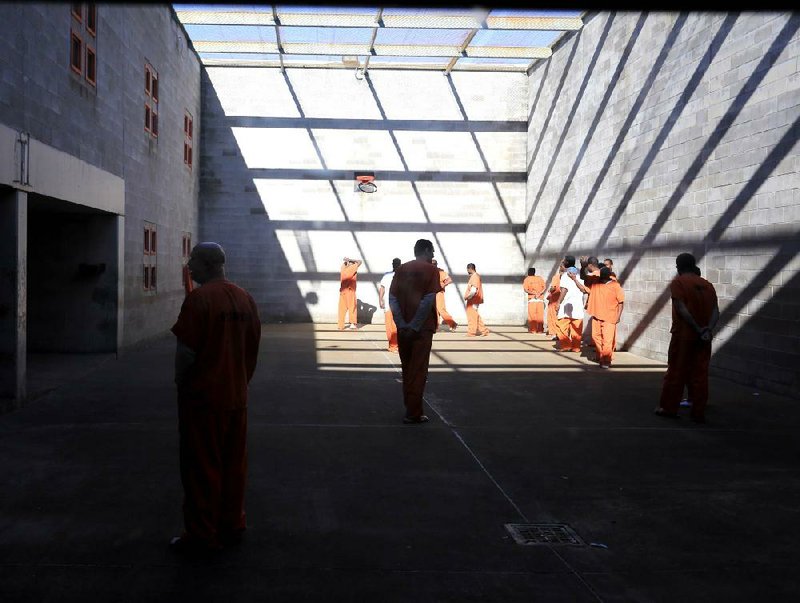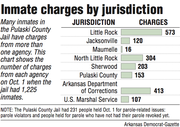The Pulaski County jail’s funding structure is up for debate in 2014, when the 20-year-old agreement between the county and cities that house inmates there expires.
About $2.3 million of the jail’s $24.9 million budget comes from the county’s five biggest cities - Little Rock, North Little Rock, Sherwood, Jacksonville and Maumelle - which agreed in 1990 to help fund an expanded county jail to house municipal inmates when it opened in 1994.
A separate 2012 agreement that expanded jail capacity provides for $600,000 more from the cities, bringing their contributions to about $2.9 million.
Pulaski County Judge Buddy Villines and the mayors of those cities are expected to meet several times after Jan.1 to hash out future funding. The agreement expires on the 20th anniversary of the jail’s opening, which is Aug. 1.
Negotiations are expected to be complicated by tight budgets and changes to the state’s parole policy that have led to the rapid rise of people held in county jails awaiting parole hearings or who have recently had their parole revoked.
“It’s a terrible predicament,” Pulaski County Sheriff Doc Holladay said.
Most cities in Arkansas have given up their jails in favor of county detention centers, said Chris Villines, director of the Association of Arkansas Counties. He said some counties in the state also have interlocal agreements to fund their jails but that many counties, especially small ones, don’t need them.
According to Arkansas Code 12-41-506, quorum courts have the legal authority to create an ordinance establishing a daily fee to charge municipalities for inmates held for them if no funding agreement is in place between the county and the cities.
THE AGREEMENT
In 1990, all cities in Pulaski County that had jails agreed to give them up and expand the county jail, the construction of which was funded by a yearlong county sales tax in 1991. But the continued funding of the jail’s operation was left up to the county.
City officials agreed to contribute some funding based on their cities’ populations and the cost of running the jails that they had just closed. That agreement was signed by each city mayor and then-County Judge Rita Gruber.
The payments were fixed amounts that increased every five years. The cities agreed to pay $1.3 million for the first five years of operating what jail officials said was a 656-bed jail.
The original agreement required the cities to pay $1.8 million in 2013 for what has become a $24.9 million, 1,210-bed jail. But as the jail grew, the cities agreed to pay $2.3 million every year to include 80 more beds, and small contributions were also made by Cammack Village and Wrightsville, respectively, according to statistics provided by county Comptroller Mike Hutchens.
In late 2012, when the five largest cities agreed to pay about $600,000 more to open additional beds at the jail, the total contribution from cities rose again to $2.9 million. The county’s contribution, meanwhile, has grown far bigger.
“We’re eating the inflation,” County Judge Buddy Villines said.
Placing an inflation factor into the next agreement is Villines’ top priority. He said Pulaski County has not had a permanent tax increase since 1982, and has gone from paying $4.5 million for its original jail to paying more than $20 million for the current jail.
“Beyond that,” he said, “I’m pretty flexible.”HOW TO FIX IT
Some of the mayors have said they would be willing to discuss factoring inflation into the next agreement. But overall, the officials are concerned with making sure their cities pay what they think is a fair amount.
Most mayors said their cities were already paying too much. North Little Rock and Maumelle have even tapped into reserve money for their 2014 budgets, and Jacksonville Mayor Gary Fletcher said he’s worried his city might have to do the same.
Last year, Maumelle Mayor Mike Watson created spreadsheets using jail data to determine how much each city should pay for the most recent 80-bed expansion.
Watson said he used the data to negotiate a smaller payment than what the county had asked for from the cities last year and that he’d like to use his formula to negotiate the new agreement. Watson’s formula allocates $1 per person in each city’s population plus $17.88 per each agency’s arrest.
Little Rock Mayor Mark Stodola said he’s not sure there’s even a need for another agreement, noting that only the county is constitutionally mandated to provide the jail. He said he would prefer to have a noncontractual agreement for each city to fund the jail and added that Little Rock would voluntarily continue to funnel in the nearly $2 million it’s currently obligated to pay.
“I’m committed to continuing to help,” he said.
Holladay joined Stodola, arguing that the cities likely can’t afford to pay more than they are already paying. He said the county should to try to find an alternative funding source, although he didn’t have a suggestion as to what that would be.
The Association of Arkansas Counties website outlines three ways counties can fund jails: a special tax, increased booking fees and other jail-related fees, and reimbursement from outside agencies that have inmates in the jails.
Sherwood Mayor Virginia Hillman and Watson said not continuing a portion of the original tax to build the jail that could have funded the jail’s operation was a big mistake, leading to the complicated situation officials are in now.
Since the construction of the jail, a one-fourth percent jail tax has been voted on twice and lost both times, most recently in 2006.
Another factor is that the county jail has 160 unused beds that haven’t been funded, but officials aren’t sure that would come up in negotiations.
“I don’t know where I’d come up with any extra money for it,” Stodola said.
Officials agree, however,that funding a jail twice as big as it was 20 years ago is just a short-term solution to a bigger root problem.
“Jails are like highways,” Villines said, “you can’t build yourself out of the problem.”
Villines said Pulaski County was just a reflection of a nationally failing war on drugs.
“We take a lot of prisoners, but we’re not winning the war,” he said.
THE STATE’S ROLE
The agreement is approaching expiration as the county jail has experienced an increase in inmates held for the state prison system who are awaiting parole hearings or have just had their parole revoked, further strapping tight funds.
Community Correction Department spokesman Dina Tyler said the state has no funding mechanism for repaying county jails for people held for parole and awaiting a revocation hearing, only new commitments to the Arkansas Department of Correction.
Holladay said the Pulaski County jail is owed more than $400,000 for holding inmates from Aug. 1 to Nov. 30.
From Aug. 15 to Nov. 21, the jail’s population was over capacity nearly every day, according to statistics from the Pulaski County sheriff’s office.
After Nov. 21, Holladay said, that strain was eased as other county jails began taking some inmates when Holladay warned that the jail might have to close to nonviolent offenders.
Since then, the state has picked up inmates from county jails and cleared some space for them by invoking the Emergency Powers Act, which releases prisoners up to 90 days before their parole eligibility, Tyler said.
“I don’t think anyone wants to use it [the Emergency Powers Act] … but it’s become part of the reality,” she said.
Tyler predicted the population of parole violators and other state inmates in county jails would go down as some inmates are released on electronic-monitoring systems and others are picked up by the state after the Emergency Powers Act is invoked periodically. But, she said, going back down to the levels that the jails were at before changes to the state’s parole policies is going to take some time.
“I don’t think it will be as dramatic of a drop as it was a rise,” she said.
In 2014, the state Legislature will hear Gov. Mike Beebe’s request for $13 million to open more prison beds and to pay back county jails for holding state inmates while the prisons have been full.
The state provides $28 per day for Department of Correction inmates held in a county jail, an amount that Pulaski County officials, mayors and the Association of Arkansas Counties argue is grossly below the actual cost of holding inmates each day.
According to statistics from the sheriff’s office, the cost of each inmate per day at the Pulaski County jail is $42.17, including medical and personnel costs.
Hillman and Fletcher said the county is essentially “subsidizing” the state with a reimbursement rate that low.
“I’m not going to pay more when the state’s getting a sweetheart deal,” Fletcher said.
Each year, the Association of Arkansas Counties puts together an Inmate Cost Report urging the state Legislature to increase the $28 amount agreed upon in 2001, asserting that the actual average cost per inmate in an Arkansas jail is now more than $50.
“I think it’s telling to the inequality being paid [to the counties],” Chris Villines said.
Front Section, Pages 1 on 12/23/2013

